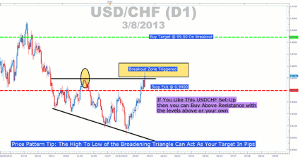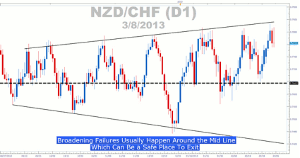Breakout and reversalprice action patterns are very useful because once a currency pair has shown its hand and taken the next step of continuing or breaking out, you can trade with very specific risk levels, writes Tyler Yell of DailyFX.com.
Broadening breakout patterns are easy to recognize because they can look like a megaphone with a broadening form on both sides or with one side broadening and the other side acting firm. The firm side will either be support or resistance and we’ll use the firm side to target breakouts. Naturally, support is seen when the lower price holds firm and resistance is seen when the top price holds firm like we see below on USD/CHF.
Specific Targets Make This Pattern Attractive

Created with Marketscope/Trading Station II
Click
to Enlarge
The reason for the broadening aspect of the pattern is volatility. Each swing in the pattern is due to increasing volatility and the snap back is more violent than before until the pattern breaks. In a harmonic pattern, the chart swing highs in the broadening pattern will display a Fibonacci extension of 1.27 to 1.61 of the prior swing but that is not required for the pattern to play out.
Trading the Broadening Pattern
There are two ways to trade these types of patterns. Each method has defined risk, which is key and as always we recommend that you use appropriate trade size in relation to your account. The two methods are trading either the breakout of the pattern or the continuation of the broadening pattern.
Breakout Trading
When trading the breakout, like we see above, the trade is taken above a break of resistance or below a break of support. Currently, on USD/CHF, we see a break above the resistance that has held since September of 2012. When price closes outside of broadening pattern and you see the following candle’s body completely above the pattern, then you are free to trigger the trade.
The risk point on breakout to the upside would be below the low of the last candle within the pattern. Likewise on a breakdown through support, the stop exit would be above the high of the last candle within the pattern. The profit target is nice and clean in that on a breakout trade, you take the largest swing low to swing high distance or pattern height and use that as your target from the breakout price.
Trading the Swings Within the Pattern

Created with Marketscope/Trading Station II
Click
to Enlarge
A great trade with limited risk is present when price touches and bounces off a broadening trend line. This is where you can take advantage of the broadening pattern and the volatility that accompanies the pattern. The risk and reward are also well defined on the swing trade.
The risk or stop exit on a sell would be at the level of the highest high when the candle touched the broadening trend line and then moved back down. The profit target has two options, one conservative and one aggressive. The conservative option would be at the mid-point of the pattern and the aggressive option would be near the bottom of the broadening pattern.
The 5 Wave Rule and Broadening Failures
Broadening patterns often have five full waves to them, but not always. Each swing is higher than the previous swing and that is why you’re presented with the megaphone type display. The key swing is the 5th swing because the pattern is well formed, and you can catch the largest move with very tight risk.
Broadening Failures Still Provide Trade Opportunities

Created with Marketscope/Trading Station II
Click
to Enlarge
A broadening failure takes place when price doesn’t complete the swing. This is a level where traders can look to exit because one way or another, it is often hit. If there is a bounce off the mid-line, you’ll often see price retrace back to the broadening trend line.
A key aspect to trading this pattern well is staying flexible and keeping a strong risk: reward level. Trading this pattern doesn’t require many indicators, but can help you catch nice moves.
By Tyler Yell, Trading Instructor, DailyFX.com


















